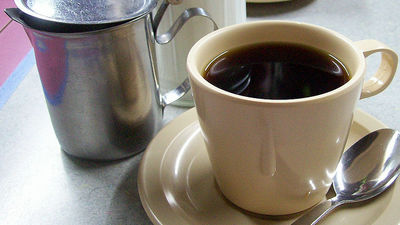Research report that coffee has a good influence on surrounding biodiversity

byUnited Nations Photo
Whether coffee that many people drink and drinks is good for the body depends on theoriesAlthough it is a part, the influence of coffee on the environment is also being studied. A report that the cultivation of coffee does not adversely affect the ecosystem, rather it has a good influence on biodiversity, "Birds and legumes: Comparison of abundance and uniqueness of birds in Arabica and Robusta type agricultural forests in the West Ghats mountain range of IndiaIn the following paper entitled Scientific Electronic JournalScientific ReportsWas announced in.
Birds and beans: Comparing avian richness and endemism in arabica and robusta agroforests in India's Western Ghats | Scientific Reports
https://www.nature.com/articles/s41598-018-21401-1
The Connections Between Coffee and Biodiversity | JSTOR Daily
https://daily.jstor.org/the-connections-between-coffee-and-biodiversity/
Originally Africa's native coffee nook is cultivated all over the world mainly in tropical regions as product crops. In most areas coffee has been brought in from outside by humans, so what has been concerned about how the cultivation of coffee will affect the surrounding environment.
Also, as the demand for coffee increases worldwide and prices rise, more coffee plantations are made, but farmlands basically open up forests and make it. In addition, it was pointed out that the use of pesticides will destroy the surrounding ecosystem by using it a lot. Particularly in the previous studies, there were voices that Rovusta species, which are more resistant to disease and easier to cultivate, are enlarged, and more environmental influences are given to surrounding environments.

byby Australian Embassy Jakarta
The world's sixth largest coffee producerIt is IndianWest Ghats MountainsFrom around the ancient times two varieties of Arabica and Robusta coffee have been cultivated. Also, in the vicinity of the Western Ghats mountain range, unlike the South American cultivation method which grows coffee trees one by one in open lands, it adopts a method of cultivating coffee in the shade so as to be clustered under a large tree It is said that there are many farmers.
In India, it is said that the cultivation area of Robusta species increased by 840% and the arabica cultivation area increased by 327% from 1950 to 2015, but in the vicinity of the West Ghats mountain range, the forest is not cut completely and cultivation that uses less agricultural chemicals , It is known that the adverse effect of coffee plantations on surrounding forests is much less than in other areas.
Therefore, when we investigated the birds inhabiting the coffee plantation around the West Ghats mountain range, we were able to confirm 204 unique species in the surrounding areas such as parakeet and pigeon. Also, comparing Arabica and Robusta type farms, we found that there was no big difference in the type of inhabitant birds. In addition, 19% of the farmers growing Robusta species were able to confirm that 75% of the farmers growing Arabica species are using pesticides, but the use of pesticides is not limited to the variety of birds inhabited around the farm It seems that he did not seem to have had a big influence on sex.

From this, it can not be said that the growth itself of coffee has an adverse effect on the surrounding ecosystems, and the influence on the surrounding biodiversity is rarely changed by the variety of coffee. As long as the cultivation method with less influence on the forest like around the West Ghats mountain range, it turned out that a rich ecosystem was formed by birds gathering like coffee beans.
However, this research is limited to birds, and it has not been reported what kind of influence it has on other reptiles, insects and mammals. Ecologist James MacDonald said that this research report in India is a positive news for coffee farmers but in order to cultivate coffee while maintaining biodiversity, It is pointed out that priority must be given to "simple coffee cultivation method".
Related Posts:







